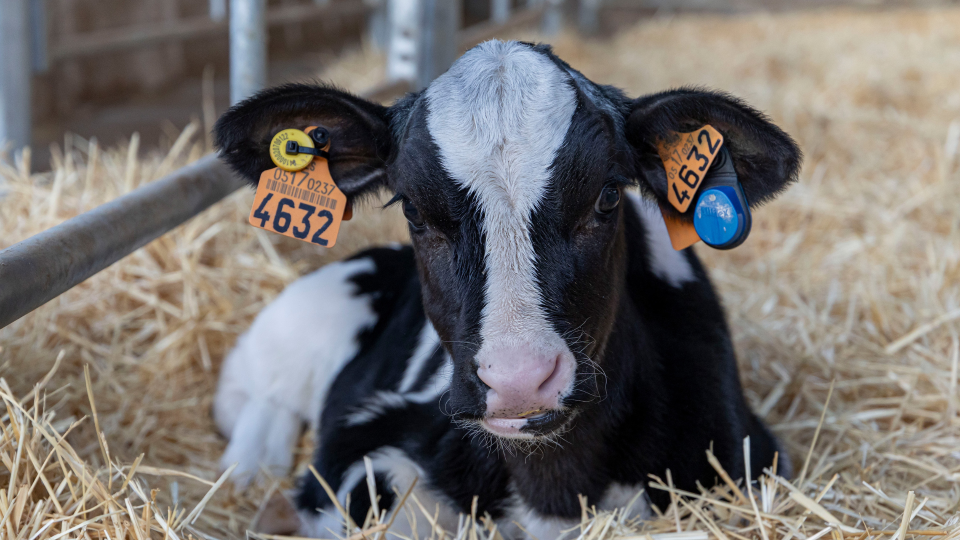Invest in Your Class of 2026
By Dr. Jonathan Townsend
Originally published by Dairy Business on August 31, 2024.
Do kindergarteners enter the first day of school with their sights set on a cap and gown? Probably not. But viewing calves as new students could help us turn healthy calves into heifers which graduate into healthy, productive cows. The class of 2026 is being born now — let’s put together the fundamentals for a successful start.

Colostrum is priority number one
Inarguably, the first fundamental is colostrum. Its importance cannot be overstated as it is a crucial step for the passive transfer of antibodies from the dam to the calf. Failure of passive transfer reduces long-term performance in dairy cattle, including delayed time to first calving, decreased average daily gain, and decreased milk and fat production at first lactation.1-3
The quantity, quality and timeliness of colostrum consumption are what matter most.
Quantity: Depending on size, most large-breed calves should receive three to four quarts of good-quality colostrum (or 10% to 12% of birth weight) as soon as possible after birth. Give an additional two quarts (or 5% of birth weight) at a second feeding, within six to eight hours after the first feeding.
Quality: Colostrum is richer in nutrients than whole milk — it is higher in energy and vitamins, contains twice as much dry matter and minerals, and has five times as much protein.4 Plus, the colostrum has lower lactose content, reducing the incidence of diarrhea.
If high-quality colostrum is not available, only use products designed to replace it. These contain more immunoglobulin and provide more antibodies than poor or moderate-quality colostrum.
To boost colostrum quality, administer a scours vaccine to the dam during the dry period, which helps increase antibodies in colostrum to protect calves against scours.
Quickness: In the first few hours after birth, maternal antibodies (primarily IgG) in colostrum are absorbed into the bloodstream, and IgG is slowly resecreted into the intestines and lungs. IgG absorption declines rapidly after birth. To meet the passive transfer goal of greater than 10 mg/mL of IgG, calves should receive sufficient colostrum within six hours of birth to bolster their immune defenses.5
The Dairy Calf and Heifer Association (DCHA) publishes its “gold standards” for growing efficient, healthy and profitable animals. According to these benchmarks, the target growth rate for calves is 1.7 to 2 lbs. average daily gain (ADG).6 Use this as a guide for monitoring the success of your calf nutrition. Keep in mind that nutritional needs of beef x dairy crossbred calves have genetic potential for higher rates of gain and should be fed accordingly.
For all calves, introduce starter feed to encourage early rumen development and provide clean, fresh water for hydration and overall health.
Advancing calfhood nutrition
Looking deeper, dairy producers may be able to learn from cow-calf beef operations. Beef calves have been observed to nurse more than 10 times daily,7 consuming milk with a minimum of 25% to 27% crude protein (CP) and 30% fat. This can result in two or more pounds of gain daily.8 On the other hand, dairy calves historically were often fed two times daily, consuming in total one pound of 20% CP, 20% fat milk replacer diluted in one gallon of water per day. This feeding program would be predicted to result in approximately 0.4 pounds of average daily gain.
These stark differences are certainly part of what makes dairy and beef animals unique. But is there something more to be learned? A more intensive calf feeding regimen could pay off. Here is an example of what a more intensive feeding regimen could look like:
Milk replacer: 28% CP, 15 to 20% fat.
- Feed 1.8 lbs. per day in 2 feedings of 2.5 quarts each for the first week of life.
- Feed 2.6 lbs. per day in 2 feedings of 3.5 quarts each for weeks 2 through weaning.
The DCHA provides ADG targets in their Gold Standards that are helpful benchmarks for the different stages of growth, depending on age and mature bodyweight.6 When reaching this growth, you’ll achieve lean muscle gain, improve calf health and immune system function and receive dividends down the road. A more intensive nutrition regimen for calves has been proven to improve first lactation production by +/- 1,000 lbs., impact mammary system development, support the possibility of a younger age at first calving and improve replacement heifer size.
Introduce starter feed to all calves to encourage early rumen development and provide clean, fresh water for hydration and overall health.
Vaccination: Building on maternal immunity
With a good colostrum and nutrition approach now logged, vaccination is the second fundamental in the journey of a healthy calf. Vaccination prepares the young immune system of a calf for what challenges may lie ahead. Those challenges could be many: a trip in a trailer, transitioning into group housing, weaning and much more.
As you develop your vaccination “curriculum” or protocol, your herd veterinarian should be your key resource. Together, you’ll identify the most important disease challenges vaccination can thwart. After all, vaccination plans aren’t one-size-fits-all.
Core vaccines protect against common and severe diseases that pose significant threats to calf health. Examples include vaccines for clostridial diseases, bovine respiratory syncytial virus (BRSV), bovine viral diarrhea virus (BVDV) and infectious bovine rhinotracheitis (IBR).
Additional vaccines may be necessary based on regional disease prevalence and individual farm circumstances, such as diseases like salmonellosis, rotavirus or coronavirus. Ask your veterinarian what additional vaccinations to consider for your herd.
There are two main categories of cattle vaccines: intranasal and injectable. Both can provide valuable immunity against virus challenges at unique stages of life. Intranasal vaccines are often the first vaccines a calf receives. Maternal antibody interference does not affect intranasal vaccines, which may impede certain injectable vaccines from inducing an immune response.9-10
Other benefits of intranasal vaccines include:
- No risk of injection site reactions — easier on the calf.
- Less likely to induce systemic inflammation compared to injectable vaccines.11
- Reduces effects of bacterial endotoxins contained in injectable Mannheimia haemolytica and Pasturella multocida vaccines.12
- Initiates a relatively rapid immune response.13
Injectable vaccines are labeled as modified live or killed formulations. Your veterinarian can help you choose the best products for your situation.
Remember, vaccines must be handled, stored and administered correctly to be effective. Use vaccines that have been stored out of sunlight, at the proper temperature and within their expiration dates.
Facilities essentials
Whether you house calves individually or in groups, in a barn or primarily outdoors in hutches, benchmarks can guide your facilities’ airflow, spacing, comfort and cleanliness. These facility considerations aim to provide a comfortable, clean, stress-free environment for calves to make a strong start.
Airflow: To reduce the concentration of airborne pathogens in calf housing, ensure good air circulation, incorporating both natural ventilation and positive pressure ventilation.
Spacing: To help prevent disease spread, house calves individually or in small groups, providing approximately 30 square feet or more of bedded space per calf, not including service alleys.
Comfort and cleanliness: Ensure pens have drainage underneath and plenty of bedding in cool weather (50 F or less). Maintain clean and hygienic calf pens, equipment, feeding areas, and surfaces.
You may recall kindergarten as “all play,” but the fundamentals taught at this early age are critical for intellectual success down the road. The same is true for calves. Proper care during the early weeks and months is essential to build a foundation for a successful transition to adulthood. The only difference is that dairy producers have two years, instead of 18, to prepare their classes for success.
References
- Waltner-Toews D, Martin SW, Meek AH. The effect of early calfhood health status on survivorship and age at first calving. Can. J. Vet. Res. 1986;50(3):314-317.
- Robison JD, Stott GH, DeNise SK. Effects of passive immunity on growth and survival in the dairy heifer. J. Dairy Sci. 1988;71(5):1283-1287. doi:10.3168/jds.S0022-0302(88)79684-8. https://pubmed.ncbi.nlm.nih.gov/3135297/. Retrieved Jul. 23, 2024.
- DeNise SK, Robison JD, Stott GH, Armstrong DV. Effects of passive immunity on subsequent production in dairy heifers. J. Dairy Sci. 1989;72(2):552-554. doi:10.3168/jds.S0022-0302(89)79140-2. https://www.sciencedirect.com/science/article/pii/S0022030289791402. Retrieved Aug. 8, 2023.
- Davis CL, Drackley JK. The Development, Nutrition, and Management of the Young Calf. Iowa State University Press. 1998.
- Modified from: The Compendium. 1993;15:335.
- Dairy Calf and Heifer Association. Gold Standards. Third Edition. Setting the benchmarks for your herd’s future. Production Standards. 2020;9-12. https://calfandheifer.org/wp-content/uploads/2020/09/DCHA_GoldStandards_2020_En_WEB-final.pdf. Jul. 23, 2024.
- Kour, H., Corbet, N. J., Patison, K. P., and Swain, D. L. Changes in the suckling behaviour of beef calves at 1 month and 4 months of age and effect on cow production variables. App. Anim. Behav. Sci. 2021;236:105219. https://doi.org/10.1016/j.applanim.2021.105219.
- National Academies of Sciences, Engineering, and Medicine. Nutrient Requirements of Dairy Cattle: Eighth Revised edition. Washington DC: The National Academies Press. 2021. https://doi.org/10.17226/25806.
- Osman, R., Malmuthuge, N., Gonzalez-Cano, P., Griebel, P. Development and Function of the Mucosal Immune System in the Upper Respiratory Tract of Neonatal Calves. Annual Review of Animal Biosciences. 2018.
- Merck Animal Health Study MS-N3PMH-3-19: Efficacy of vaccination in colostrum fed 7-day old calves when using multivalent intranasal vaccine in the face of maternal antibody.
- Engelken, T. J., Roth, J. A., Renter, D. G., Meyer, B. D., Burdett, W. W., and Hill, K. L. The Effect of respiratory vaccine components and route of delivery on weight gain and inflammatory response in suckling beef calves. The Bov. Pract. 2016;50(2):165–174. https://doi.org/10.21423/bovine-vol50no2p165-174.
- Merck Animal Health Technical Bulletin. Spire, M. Vista®: Endotoxin Load. 2014.
- Kesl, L., Saltsman, R., Burdett, B., Nordstrom, S., Xue, W. Determination of the Number of Days from Vaccination to Challenge Required for Protection from Infectious Bovine Rhinotracheitis (IBR) Virus Challenge Following Vaccination with Onset 5 IN and Vista 5 SQ in 13–30 Day Old Colostrum Deprived Calves. Publication pending. World Buiatrics. 2022.
Find more content for your dairy operation.
About the author

Jonathan Townsend, D.V.M., Ph.D.
Dairy Technical Services,
Merck Animal Health
